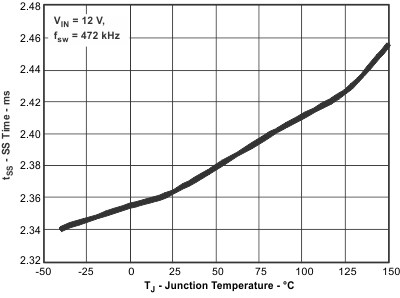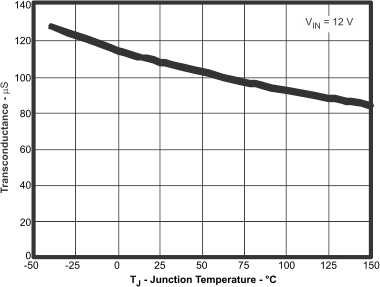SLVSBB7E May 2012 – November 2015 TPS54061
PRODUCTION DATA.
- 1 Features
- 2 Applications
- 3 Description
- 4 Revision History
- 5 Pin Configuration and Functions
- 6 Specifications
-
7 Detailed Description
- 7.1 Overview
- 7.2 Functional Block Diagram
- 7.3
Feature Description
- 7.3.1 Fixed Frequency PWM Control
- 7.3.2 Slope Compensation Output Current
- 7.3.3 Error Amplifier
- 7.3.4 Voltage Reference
- 7.3.5 Adjusting the Output Voltage
- 7.3.6 Enable and Adjusting UVLO
- 7.3.7 Internal Slow-Start
- 7.3.8 Constant Switching Frequency and Timing Resistor (RT/CLK Pin)
- 7.3.9 Selecting the Switching Frequency
- 7.3.10 Synchronization to RT/CLK Pin
- 7.3.11 Overvoltage Protection
- 7.3.12 Thermal Shutdown
- 7.4 Device Functional Modes
- 8 Application and Implementation
- 9 Power Supply Recommendations
- 10Layout
- 11Device and Documentation Support
- 12Mechanical, Packaging, and Orderable Information
Package Options
Mechanical Data (Package|Pins)
- DRB|8
Thermal pad, mechanical data (Package|Pins)
- DRB|8
Orderable Information
6 Specifications
6.1 Absolute Maximum Ratings
over operating free-air temperature (unless otherwise noted)(1)| MIN | MAX | UNIT | ||
|---|---|---|---|---|
| Voltage | VIN | –0.3 | 62 | V |
| EN(2) | –0.3 | 8 | V | |
| BOOT-PH | –0.3 | 8 | V | |
| VSENSE | –0.3 | 6 | V | |
| COMP | –0.3 | 3 | V | |
| PH | –0.6 | 62 | V | |
| PH, 10ns Transient | –4 | 62 | V | |
| RT/CLK | –0.3 | 6 | V | |
| Current | VIN | Internally Limited | A | |
| BOOT | 100 | mA | ||
| PH | Internally Limited | A | ||
| Operating junction temperature | –40 | 150 | ºC | |
| Storage temperature, Tstg | –65 | 150 | °C | |
(1) Stresses beyond those listed under Absolute Maximum Ratings may cause permanent damage to the device. These are stress ratings only, which do not imply functional operation of the device at these or any other conditions beyond those indicated under Recommended Operating Conditions. Exposure to absolute-maximum-rated conditions for extended periods may affect device reliability.
(2) See Enable and Adjusting UVLO section
6.2 ESD Ratings
| VALUE | UNIT | |||
|---|---|---|---|---|
| V(ESD) | Electrostatic discharge | Human body model (HBM), per ANSI/ESDA/JEDEC JS-001, all pins(1) | ±2000 | V |
| Charged device model (CDM), per JEDEC specification JESD22-C101, all pins(2) | ±500 | |||
(1) JEDEC document JEP155 states that 500-V HBM allows safe manufacturing with a standard ESD control process.
(2) JEDEC document JEP157 states that 250-V CDM allows safe manufacturing with a standard ESD control process.
6.3 Recommended Operating Conditions
over operating free-air temperature range (unless otherwise noted)| MIN | MAX | UNIT | ||
|---|---|---|---|---|
| Input coltage | 4.7 | 60 | V | |
| Output current | 200 | mA | ||
| Switching frequency set by RT/CLK resistor | 50 | 1100 | kHz | |
| Switching frequency synchronized to external clock | 300 | 1100 | kHz | |
6.4 Thermal Information
| THERMAL METRIC(1) | TPS54061 | UNIT | |
|---|---|---|---|
| DRB | |||
| 8 PINS | |||
| RθJA | Junction-to-ambient thermal resistance | 42.9 | °C/W |
| RθJC(top) | Junction-to-case (top) thermal resistance | 46.0 | |
| RθJB | Junction-to-board thermal resistance | 18.1 | |
| ψJT | Junction-to-top characterization parameter | 0.5 | |
| ψJB | Junction-to-board characterization parameter | 18.3 | |
| RθJC(bot) | Junction-to-case (bottom) thermal resistance | 3.0 | |
(1) For more information about traditional and new thermal metrics, see the IC Package Thermal Metrics application report, SPRA953.
6.5 Electrical Characteristics(1)
TJ = –40°C to 150°C, VIN = 4.7 to 60 V (unless otherwise noted)(1) The Electrical Characteristics specified in this section will apply to all specifications in this document unless otherwise noted.
6.6 Typical Characteristics
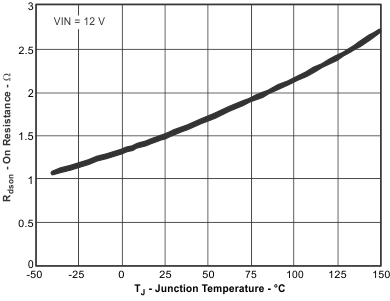
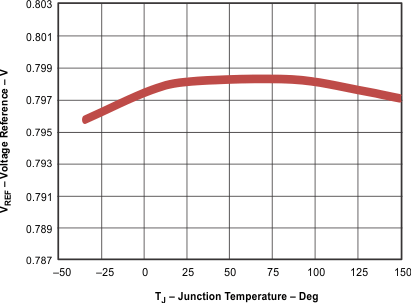
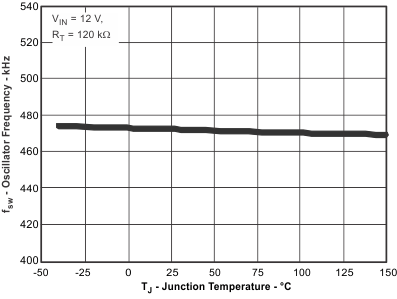
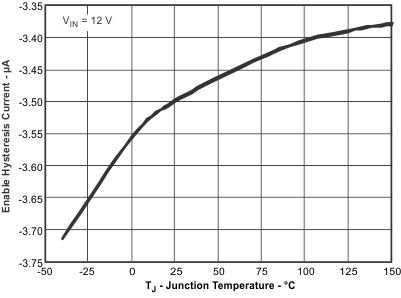
vs Temperature
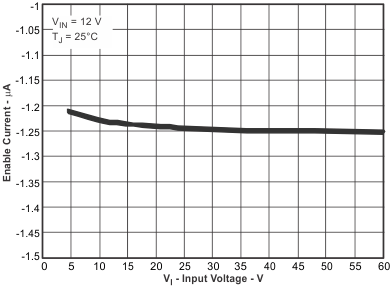
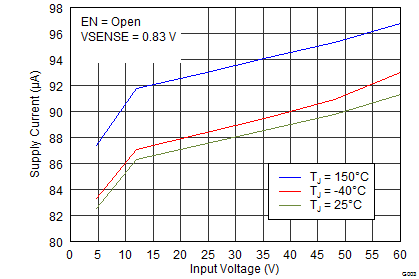
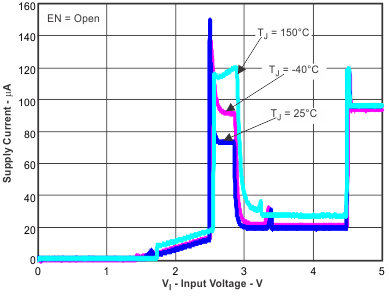
A.
Figure 15. Supply Current (VIN Pin) vsInput Voltage (0 V to VSTART) En Pin Open
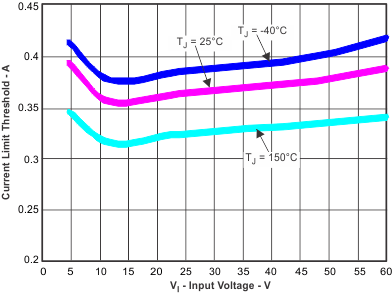
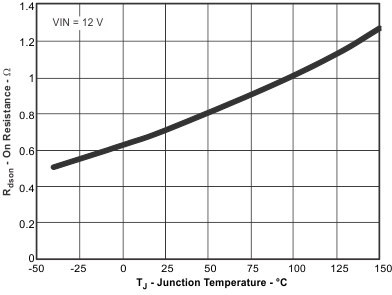
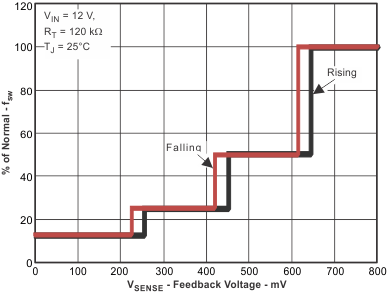
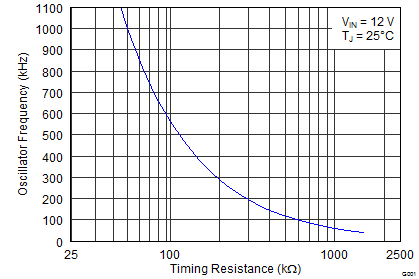
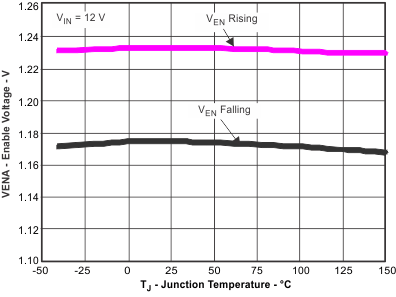
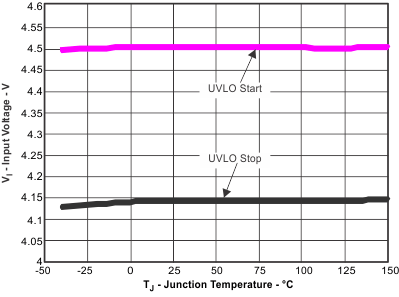
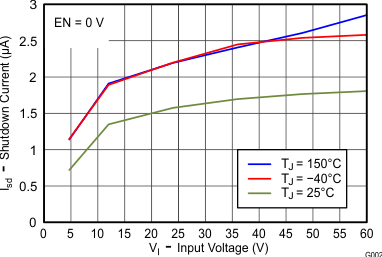
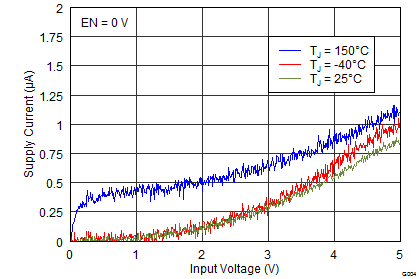
A.
Figure 14. Supply Current (VIN Pin) vs Input Voltage (0 V to VSTART) En Pin Low
